Text
Plane Movie Roundup #1
Initially it felt a little weird to group things as Plane Movies, but then I thought about it some more, and… well, have I really watched something if I've only watched it on a plane? Yes, but also no. I think it’s helpful context to remember I watched something tired, distracted, and with the constant rumble of a jet engine blaring in my ear.

The Wonderful Story of Henry Sugar
I actually watched all of this series of shorts except this one last year (The Rat Catcher was my fav), but just now got around to Henry Sugar. So, this applies to all of them, but - I absolutely love the style these shorts are done in. The rapid, feverish monologues while the actors stare the audience down complements Wes Anderson’s style to a T, and the constant shuffle of the sets and stagecraft is enthralling. The actors all swapping between multiple roles adds a very odd drama to the proceedings, and the casting was great as well - I can’t imagine someone I’d rather have locking eyes with me and calmly reciting narration than Richard Ayoade.
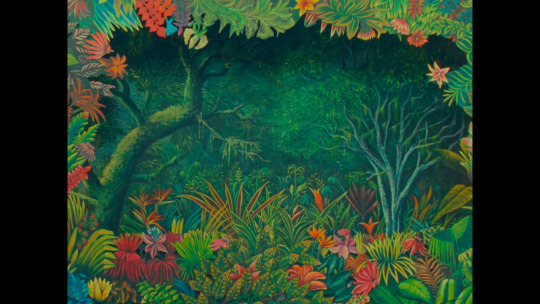
Anyway, Henry Sugar in particular was alright. The slow unveiling of the mystery in the first half kept my attention, but when all was said and done it felt a little saccharine. I thought it started to broach a genuinely interesting discussion about the class disparity of skill mastery: for all that we romanticize the idea of the starving artist, isn’t an independently wealthy person, who doesn’t have to spend time worrying or doing anything about their bills, plans or obligations*, able to have a fast track to bettering any skill they want? Doesn’t it feel particularly frustrating that despite creative arts typically being seen as a pure expression of emotion and feeling, due to the massive time investment required to excel, they're tied up in social status just like everything else? The example here was even particularly salient to examining that idea, given the inherent spirituality often suggested by meditation which Sugar clearly lacks.
*Not to mention the cost of equipment and the networking / connections required to actually make a career out of something creative, even if you’ve already gained the skill to do it
And yet, in a twist even more unrealistic than being able to see through solid objects with one’s eyes closed, the laughably wealthy man decides to use his new wealth-gaining technique to better the world and help those around him. What a fairy tale.
Part of me wishes it followed the hinted-at horror tangent of Sugar being unable to see anything beyond the base organic makeup of all the bodies around him… but we have Luther Strode for that, I guess.

Spaceman
Wasn’t really impressed by this movie… I think what the creators found interesting about the premise and what I found interesting about the premise were drastically different. If you came here for Space Madness – Is This Man Really Hanging Out With a Giant Spider or Not??, well, that sucks, because Spaceman is largely disinterested in questioning Jakub’s sanity and is content to accept Hanuš as his giant space therapist with very little fuss. If you’re here for Loneliness in Space – Can One Even Begin to Fathom the Ultimate Desolation of the Void??, again, not so much.
Instead, the movie is essentially Toxic Man Who Was Shitty to His Wife and Spends Way Too Much Time at Work Realizes That’s Bad While in Orbit of Jupiter which… didn’t do much for me. Feels real easy to have an epiphany about how you were wrong when you’re half a solar system away and can’t actually work on that problem in any meaningful way… and then the way he tries reaching out is by sending a generic, manipulative message to his wife and then immediately flinging himself out of his ship on a suicidal one-way spacewalk? Doesn’t really feel like you meaningfully learned your lesson, my guy.

The ridiculousness of the spider did result in some great moments, though. Hanuš rollin out of the pantry eating nutella while saying “Hey, tough break bud, that sounds really rough” like he’s Adam Sandler’s fuckin college roommate was pretty choice.
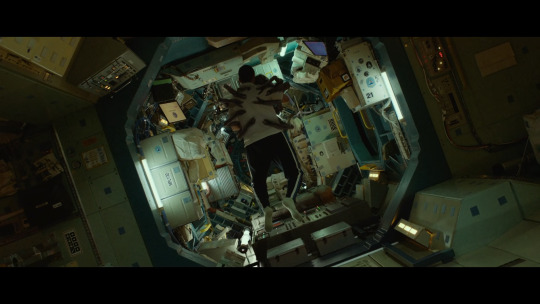
Enter the Dragon
Initial thoughts: god damn Bruce Lee is hot as fuck
Latter thoughts: god damn Bruce Lee is scary
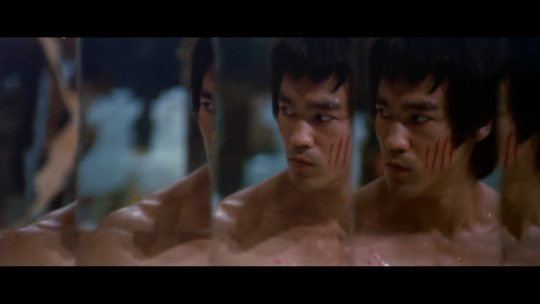
This was my first Bruce Lee movie… and what a trip it was. From the jump, I felt like I was out of my depth in a weird way when he started talking about ‘emotional content’, but still, I enjoyed this from an aesthetic standpoint if nothing else.
Mostly, Enter the Dragon was one of those movies where upon watching it, dozens of other things clicked into place in my head - media that was inspired by it, media that has parodied it, media that’s reverent towards it. And here, unlike many other times where I’ve first experienced older, hugely influential works, I was immensely entertained. The music is groovin start to finish, it has some of the best funny cheese moments (Bruce throwing the snake into the guardroom, the facility guards walking around with nunchuks like that’s a thing that anyone does), and the fight choreo is killer. Lee absolutely schooling O’Hara in their duel with that move like water shit… mmm. Give me more of that.

Okay, so the other thing that really struck me is how fucking scary Bruce Lee is in this movie. Now, maybe I just think of kung fu movies as lighthearted due to their constant parody in pop culture, or because the ones I actually grew up with, like Kung Fu Hustle, are decidedly comedic - but even putting that aside, I think Enter the Dragon genuinely is intentionally tongue-in-cheek much of the time. It even plays into the nonviolent, “don’t worry, they’re just sleeping” trope with Bruce only knocking out the guards on his nighttime excursion. So it came as a real shock every time Bruce Lee just straight up fucking brutally murdered a dude. Look, with O’Hara it makes sense, he absolutely had it coming, but it’s still wild to watch the camera slowly pan into Bruce Lee’s face, fully focusing on his thousand-yard-stare, theremins going wild in the background. Not a man to fuck with.

#will's media thoughts / virtual brain repository#movies#the wonderful story of henry sugar#spaceman#spaceman 2024#enter the dragon
0 notes
Text
Girl Juice and Michael DeForge
Girl Juice

P good. It has some absolutely hysterical, standout moments, but overall didn’t leave as much of an impression as I was expecting it to. I dunno, I might’ve just been expecting more of an ensemble thing, when in fact everything’s more or less centered around Bunny. She’s a pretty commanding character, for sure, but the humor loses a bit of its luster when she’s the punchline nearly every time.
I think the format contributed to this wear a little bit. Girl Juice is structured a bit like a comic strip / webcomic compilation, where each page is ostensibly its own standalone story; when they’re more straightforward gag strips with a payoff, they usually kill, but there’s some bits on the first half where it tries to be a bit more narrative / slice of life, and the layouts start to feel stiff and restrictive.
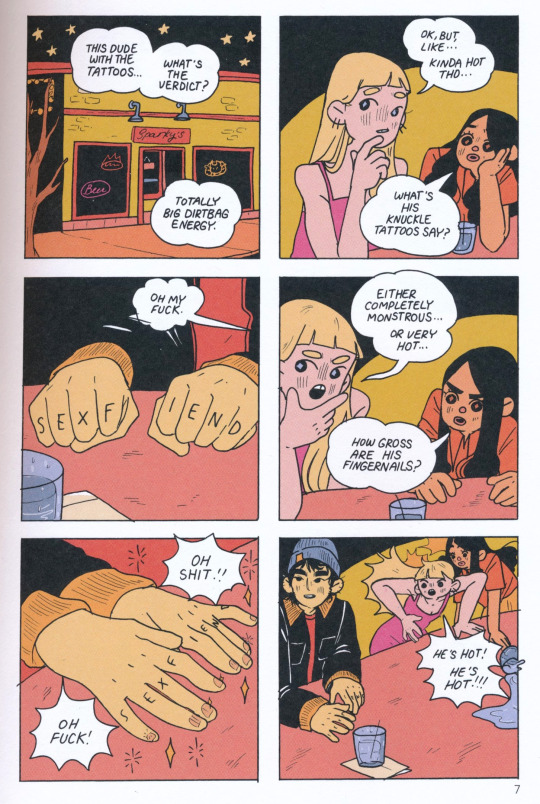
I did appreciate the ending story for branching out a bit in that regard, with deviation in both the paneling and the pacing.
Overall, the art and vibe and character designs are incredibly charming, and I quite like the author’s voice for dialogue, I just think medium-wise it’s a bit clumsy at times.

Also the slow drip feed of clownlore about Nana was fucking wild. The first time it dropped the clown fetish thing it was a fun one-off gag, then we see her clown boyfriend and hear about her clowning aspirations, and things start snowballing - by the end she’s wearing full-on clown outfits with ruffs and buttons, and suddenly I realize that her red nose, which I assumed was an artistic choice and didn’t think twice about, is a big ol clown honker she puts on / paints every day?? yo.
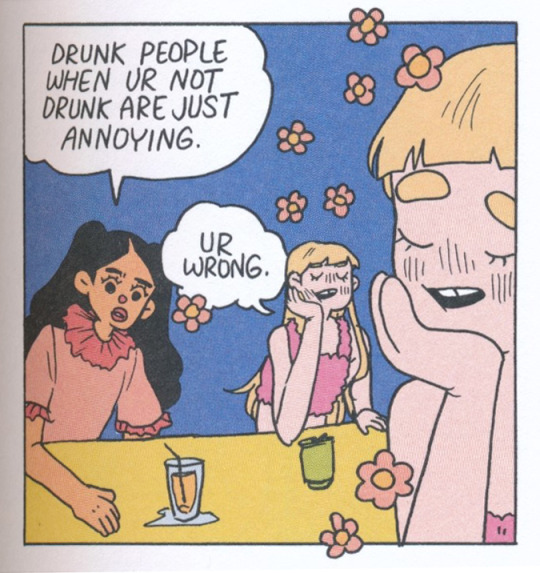
---
Sticks Angelica, Folk Hero
Reading Sticks Angelica, Folk Hero consistently filled me with the same delight that first reading the title Sticks Angelica, Folk Hero did. which I consider a success story

This is probably my favorite thing I’ve read from Michael DeForge. I think (unintentionally) everything else I’ve read from him are collections of shorts, so it was kind of a shock to get something with this much of a throughline. DeForge is so confident with his style here, and I felt the longer format really gave him time to fully explore the tone and visual style of this setting.
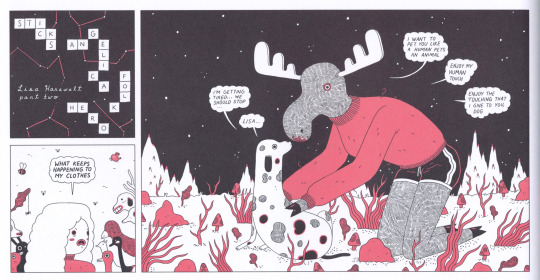
The art is gorgeous throughout, and remains cohesive while still featuring lots of experimentation and playfulness. The tritone coloring is eye-catching, and DeForge really makes the most of it by constantly messing with line variation and texture, adding a huge variety of middle values even between each of the three printed colors. The book, generally, is incredibly lavish - while heavily stylized, both the characters and backgrounds are popping with detail and incredibly graphic, and it feels like DeForge rarely repeats himself with his visual effects. Lots of cartoonists making a strip-based story like this find a trick for certain elements then put them on autopilot; as if to make up for the book’s general artstyle not changing for once, DeForge instead finds new tricks for each element constantly.
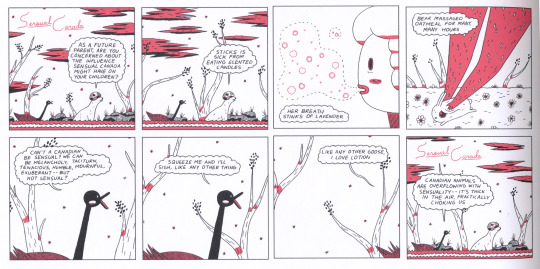
All the designs are incredibly memorable, too, from the geese with their mouths constantly agape to the fuckin constantly sweating outline bear.

“Why should [she] be the exception? Penance is her birthright, just as this mushroom is mine.”
---
Heaven No Hell
So yeah, after the relatively cozy Sticks Angelica, hopping straight in here was a fuckin trip.

This is DeForge back on his short story bullshit, and totally nailing every one. The man is a style chameleon - if not for the titling, I genuinely think you could convince someone this was an actual anthology. Visually, not every style resonates with me, but there’s no denying the sheer variety of aesthetic inside Heaven No Hell.
On the recommendation of some internet rando, I held myself to only reading one or two stories a day, leaving time in between to digest them, and… if anything, it only made collecting my thoughts on the book more difficult. Each of the stories is so short, maybe ten pages on average, and they’re all so drastically different - the voice of the writing, the artstyle, the setting - yet they all, to a one, left me with a sense of unsettling bemusement I couldn’t shake. It’s as if you see only a brief snapshot of a story, and are yanked away before you can fully come to grips with what’s going on.
Heaven No Hell is almost short comics done as poetry rather than prose, which is a rarity in a medium so tied to narrative.

Some of them come off lighthearted - Soap Opera is one of the funniest shorts I’ve read in a minute, and the middle school murder mystery is surprisingly jovial for its subject matter (and the anti-carceral solidarity that all of the 11-year olds inexplicably share). Some are heady - the title track’s ridiculous tiered heaven system manages to strike a melancholy chord despite its flippancy (honestly bronze tier fucks tho), and the impostor syndrome society, where not a single person is who they claim to be, feels a little too real to be comfortable. Some are surreal and delirious - the war of the unreasonable, New Museum, was an incredibly potent tone piece that fully swept me up in its conceit. And then some are just legit actual nightmares, like the girl whose new ant stepdad keeps knocking up her mom, leaving clusters of giant squirming eggs rampant around the house, hatching and dying and crawling.
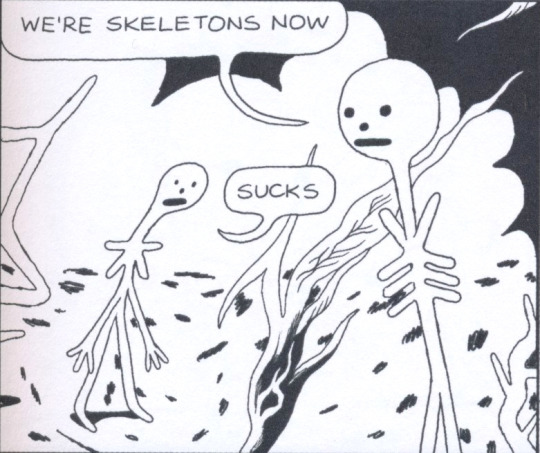
Fun panel but also this story is about a skeleton afterlife where the skeletons of every dying thing end up, their skin slowly blooming off them and collecting into a giant shell of flayed skin that girds the planet like a fleshy atmosphere
---
“When the crowd cleared out and the snow off everyone’s boots had melted, we realized that at some point in the night our bodies had crushed and killed Barnaby. Barnaby was the littlest among us. He died the way he lived: misremembering the lyrics to a Hole song. We held a service for him, just a few of us stragglers–the ones tasked with cleaning up. It ended the night. We said a few things. Everyone knew the words.”
---
In a few words: exhaustingly creative.

#will's media thoughts / virtual brain repository#comics#girl juice#heaven no hell#sticks angelica folk hero#michael deforge#long post
1 note
·
View note
Text
Planet Earth III

I don’t have too much to say here, either deeper thoughts or to record whether I liked this or not.
It’s a new Planet Earth, of course it fuckin rules.
So I’m mostly just going to save a bunch of pictures to remember some of the coolest bits.

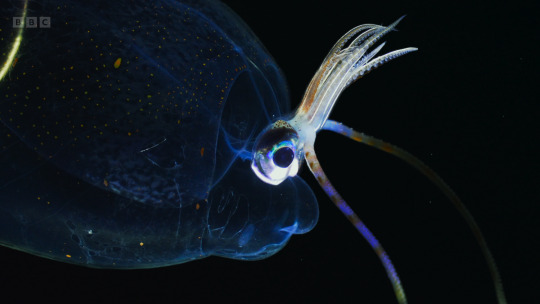



I think one of the challenges you always face with nature documentaries like this is striking a balance between accessibility and novelty. I know it sounds weird to write about A Animal being accessible, but like, if you’re an adult and have watched nature documentaries your whole life, you have seen extensive footage of dolphins and lions doing their thing, and you’re mostly here for that niche shit. Still, especially for a series with as broad a scope as Planet Earth, you always have to assume it might be someone’s first nature doc, and continue to show off the amazing things some viewers may be jaded about.

In that respect, Planet Earth III strikes a really great balance between the two extremes, and had a whole host of incredible things I’d never seen. I’d seen stills of sea butterflies before, but never in my wildest dreams imagined the nightmarish way they capture prey. The section with the jacana (lilypad-jumping bird) awakened a deep, long-dormant part of my childhood that made me want to lay every pillow in the house onto the ground and jump daringly between them. The nesting ostriches felt like a clever inversion of the usual penguin childrearing we get. Even the whales, those classic standbys, feel fresh with outstanding moments like the feeding montage*.
Also, how have I never seen underwater hippo footage?? lit.
*In general, I’m always impressed how they continue to raise the bar visually. I always think “the last one looked pretty amazing - how much better could the fidelity / shot comp have gotten?”, and the answer is always “bitch YOU THOUGHT”



I’ve said this for years, but I desperately want a modern, bug-only flagship BBC documentary. Every time they do segments at that macro scale it’s fucking wild and I want to watch hours of crazy bug shit.


If anyone knows what kind of monkey this is, hit me up. They just pan by without saying anything about it as if that's not one of the craziest motherfuckers I've ever seen


That is, in fact, aerial footage of a locust swarm


The Amazon segment, in a particularly inspired choice, is shot and scored with the creeping dread of a horror movie, showing the wild jungle being slowly overtaken by endless, identical rows of nursery farms, swaying in the wind like shambling zombies.



Of course, these docs continue to be pretty bleak the longer you watch them, due to the unchecked progress of climate change. All of the BBC productions have gotten more and more frank about how critical things are for all the featured habitats, and at this point they spend nearly a fourth of the runtime pleading for intervention. Their purpose was already essentially conservationist, by preserving footage and knowledge for future generations, so I applaud them continuing to use their platform to push for awareness. I just wish any of the people with that level of power were actually watching things like this.

0 notes
Text
Chain Gang All-Stars
Great book.

I sort of hope Chain Gang All-Stars is never adapted into a show or movie. It’s certainly possible that it could be done with proper deference to the tone and message of the book, but I think it’s far more likely that it would end up essentially being what Chain Gang is in the story itself - a hyper-violent spectacle that people tune into because they think it’s cool and action-packed. I think Chain Gang All-Stars is very successful at walking the tightrope line of drawing the reader into the story and letting them flirt with what it must feel like to be a viewer of the program, while presenting enough reminders of its grim reality to prevent you from being totally sucked in. While there were times during the LinkLyfe segments where I was drawn in the way a viewer absorbed in a reality show would be, the battles themselves never give in to ‘just’ being badass. They were tense, certainly, and I was on pins & needles reading them, worried about the characters, but there’s a certain utilitarian brutality to the writing in those sections that keeps them grounded. I’d be worried any adaptation would make everything too stylish and exciting, thoroughly missing the point*.
*To say nothing of any potential dilution of the politics to appeal to a wider audience.
—
“All other sport was just a metaphor for this.”
—
Chain Gang All-Stars is incredibly good at giving every single character a depth and fullness, even ‘antagonists’, so that even the characters who infuriate us, we understand to a degree. The book doesn't justify evil deeds - there’s no excusing Wil’s dumb ass self - but it shows how easy it is for someone to placate themselves, to keep themselves on a surface level and not dig too deep into their own morality, to convince themselves that they’ve done what they could and that all those who have wrong done to them deserve what they get. The fluid perspective switches it accomplishes this with are fascinating, too. We get chapters dedicated to different characters, of course, be it our leads, our deuteragonists, and plenty of one-off side stories - standard stuff. But Adjei-Brenyah also rapidly switches between multiple perspectives within the same page, hell, the same paragraph at times, which gives us insight into a much wider breadth of viewpoints than we normally would.
By getting to see into the inner thoughts of quite a few Links, we get to see how, while their individual experiences are different, their imprisonment has broken them all in tragically similar ways. From Bishop to Sunset to Thurwar to Staxxx, we see a consistent, crippling lack of self-worth. The A-Hamm chain is unique in preaching a vision of solidarity, accepting one’s past mistakes, and focusing on how they’ve grown and changed as people. Despite this, at their core, none of them can truly find it in themselves to be forgiven, because Chain Gang grinds their lack of perceived value into them unceasingly - ultimately resulting in what is essentially suicide. The carceral system does not allow for or encourage rehabilitation, only suffering and self-hatred.
I thought it was a compelling decision to make the majority of the imprisoned characters we follow legitimate violent offenders. A lot of the abolitionist / prison-critical literature I’ve read often focuses on, or at least begins with, incarceration that is plainly, nakedly unjust, like long-serving non-violent offenders and mandatory minimum sentencing. Conversations about the treatment of murderers, rapists, etc., are naturally more fraught - it’s harder to get someone to imagine an entirely different system, rather than just adjustments to the current system.
Chain Gang All-Stars does not shy away from it one bit. We get self-reflection from multiple different Links, both those who regret what they’ve done and those who don’t; we get conflicted thoughts from family members who recognize that their lives have been fundamentally changed by the imprisonment of their kin, but are still ambivalent about forgiveness; and we get, of course, the fearmongering and appeals to pathos used by government and the media to try and stop any ideas of abolition from even beginning to take root in the minds of the public. The book understands that there’s no easy answers, and instead brings all of these perspectives to the reader, demanding they grapple with the issues themselves.
It does, however, make clear the absurdity of pretending that taking someone whose life has been indelibly touched by violence and putting them into a system that encourages and requires additional violence, by the state, by their peers, is somehow rehabilitation. It’s brought to an extreme in the novel, of course - Thurwar’s overriding instinct that every problem can potentially be solved by violence due to the constant killing she’s done is more reminiscent of a soldier returning to peacetime than anything else - but the message stands.
Some of the most powerful parallels shine through as-is, though. Even when you put aside the horror the Links are put through on a daily basis and the rampant normalization of state-sanctioned violence, the base lack of freedom and personal autonomy is what breaks people. Both during Chain Gang and our looks at other prisons, the regimented days, planned schedule, and inability to spend time or talk with the people they care about are basic human rights that are removed from prisoners every day. Hendrix’s silent prison (an idea I was horrified to find has been enacted before) shows this in one extreme - after being robbed of something as simple as his own voice for so long, Hendrix is willing to risk everything just to be able to reclaim that part of himself.
Most heartbreakingly, the morning of the final doubles match, Thurwar’s only desire is to stay in bed longer with Staxxx. Leisure time with your loved ones, one of the most basic luxuries a person ought to have, seen as an unobtainable prize. Don’t need a dystopian near-future novel to see that happening.
Speaking of Hendrix Young, the voice Adjei-Brenyah uses for his sections was absolutely beautiful and oozing with character and I loved it. The way he speaks is simultaneously poetic yet so pragmatic - there’s an idiosyncratic turn of phrase in nearly every paragraph, and his love for the world and its beauty is never eclipsed by his cynicism and the horrible things happening around him. His sections were handily my favorites, despite the looming dramatic irony that overshadows them all.
—
“I thought of how the world can be anything and how sad it is that it’s this.”
—
As a literary device, the interspersing of worldbuilding notes and Actual Fucked-Up Prison Facts was a genius touch. By priming your brain to expect something more fantastical, the more grounded notes become something of a sucker punch. The first few are all in-universe lore explanations - they’re not entirely necessary, you could’ve pretty much got the gist through context, but the thorough explanation written almost as an ad read pulls you into the mentality of this world… so then, when it drops, say, the net worth and founding members of the Corrections Corporation of America and you get the inkling that this tidbit feels a little too specific to be made up, the lines between the book’s world and our own start to blur.
In addition to the unique cognitive dissonance it invokes, I think it’s a pretty effective strategy to convince or teach a reader who perhaps hasn’t done as much digging about the nightmare that is the American prison-industrial complex. Especially given that the main conceit of the book is a little outlandish, it’s very easy for me to imagine such a reader enjoying the story for its plot, but deflecting or doubting the themes with the classic “Oh, but this is an exaggeration - it would never happen like this! It would never be that sadistic”. In some way, the footnotes feel like the author directly responding with a “Yes, it would, and in fact has already happened this way previously”.
I do wish the footnotes stayed as dense throughout the entire book as they were at the start. In the beginning, they come hard and fast, blending the real and the fictional, keeping the reader on their toes. About a third of the way through, though, they slow to a trickle, becoming a rarity. Adjei-Brenyah keeps experimenting with what the footnotes can convey (“Don’t look down. Help me.” was particularly chilling), but the infrequency starts to make them feel like an afterthought.
—
“Just jump.”
—
The closer I got to the end of Chain Gang All-Stars, as fewer and fewer pages remained, I was increasingly desperate for something to break. Even as the story continued towards the inevitable, even as it showed me there could be no other way for things to go, I hoped for something else. Anything but what happened.
And yet… the ending gives this book’s message a lot of its power. It’s not a story where things always work out and the good guys always win - it’s a reflection of real problems, and those real problems don’t have such a simple solution. Chain Gang All-Stars is about people living in an unfair world, working within a cruel, unjust, system, and still finding the strength and conviction to believe that there can be positive change. It’s about knowing that progress can be slow, and that the system can feel daunting, and feeling powerless to enact change, and still imagining and pushing for the world to be better anyway. And somehow, that it faces that hopelessness head-on makes it more uplifting than a safer story with an easier ending.
#will's media thoughts / virtual brain repository#books#chain gang all stars#just for the sake of the journal i'll add#that reading this after rewatching the hunger games#only lowered my esteem of them even further lol
27 notes
·
View notes
Text
Children Who Chase Lost Voices
This movie is like, the poster child for why I started keeping this media journal. I’ve seen Children Who Chase Lost Voices two times before this watch, and did not remember a god damn thing about it other than vaguely liking it… it really bothers me, not being able to summon up at least a surface level reaction or feeling about a piece of art I spent time with. At last, there will be a record!

Anyway, it was aight.
Children definitely feels like Makoto Shinkai’s take on a Ghibli movie; it’s a solid attempt, but it’s missing a bit of that secret sauce.

They’re not subtle about it, either - see, for example, the Legally Distinct Fox Squirrel from Nausicaä
Visually speaking, it was interesting seeing one of Shinkai’s earlier works again after the phenomenon Your Name became; it very much feels like an aesthetic in a transitory state. At this point, CoMix Wave is beginning the pivot to an Hiroyuki Okiura-style realism* for its character animation, which would later set Your Name apart - but they can’t quite manage it yet here, leaving a lot of cuts feeling stiff and weightless. It’s stuck in a weird middle ground where, were I not aware of their progress in later works, I’d almost wonder if they would’ve been better off sticking to more stylized movement like the classics it’s based on.
*I found out after writing this that Okiura actually did key animation for Your Name, neat.

The backgrounds, always a focus of Shinkai’s work, are gorgeous. All of the scenes in Asuna’s town are my favorite - it feels lush, vibrant, and is possessed of such a sense of place.

I did find that the landscapes became a bit bland once the characters found their way into Agartha, though. If I remember correctly, location scouting and on-site compositional photography are a big part of CoMix Wave’s production process on Shinkai’s films. I can tell that was the case for Asuna’s town - it’s rendered lovingly, looks lived in, and consistently features striking angles and framing. In stark contrast, a lot of the underground scenes, while painted well from a technical standpoint, often feel flat and empty.

My partner was floored by actually seeing a cicada on-screen for once, after hearing them in literally every anime ever
The strongest element of Children Who Chase Lost Voices to me was the nuance of its characters. While it is very much a Miyazaki-style grand adventure fable, there’s not really a traditional bad guy or antagonist. We have some monsters our heroes have to get away from, and some soldiers that get in their way here and there, but there’s no mustache-twirling villain trying to harness the power of Laputa for their own evil ends or whatever - just a group of people whose paths are intersecting, and only occasionally fully parallel*.
Instead, the person who most seems closest to occupying that role, Morisaki, is just a wife guy, start to finish. Sure, he makes some fucked up choices throughout the movie (his behavior during the climax being the worst of it), but at the end of the day, he has a single motivation, a plan he’s following through with, and outside of that he’s not going to get in anyone’s way unnecessarily. He’s not out for revenge, he’s not holding grudges, he doesn’t try and force anyone to see things his way, he’s just desperate with grief and driven to accomplish his goal.
It all results in a pretty unique dynamic - turns out having your ‘antagonist’ spend the whole movie on the road with your lead gives you a lot of time to flesh them out and make them feel genuine.
*Not that Miyazaki movies never do this - Spirited Away comes to mind - but the movies Children feels most inspired by (Nausicaä, Castle in the Sky) definitely just have some villain-ass villains.

0 notes
Text
Piranesi
I write this post under the watchful Gaze of the Statue of the Gorilla in the Fifth Northern Hall. May his Strength and Resolution give me courage!
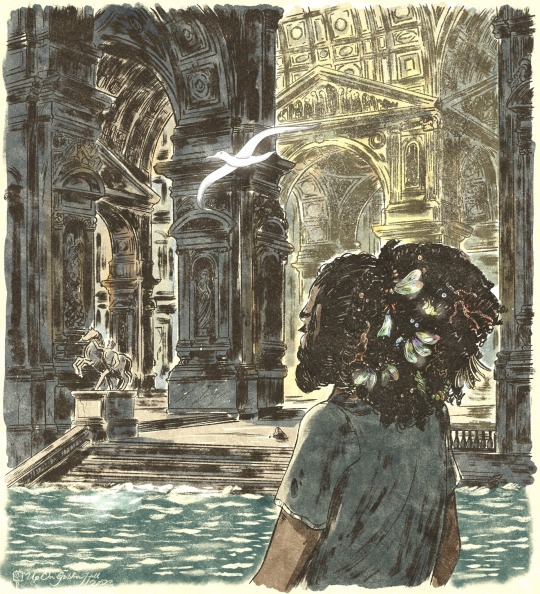
art by upongoblinhill - link to prints
I can’t remember the last time I finished a book this quickly. Piranesi’s biggest strength, I think, is in its writing and pacing. The world and setup are compelling enough on their own, don’t get me wrong, but it’s the transportative nature of the prose that refused to let me go.
It’s easy for me to imagine a version of this story written from another, more common angle: perhaps seeing the proceedings from Raphael’s point of view as she slowly unravels the mystery, or having us follow someone who has only recently entered and is still exploring the House, or even just following Piranesi’s journey from a detached perspective that treats his worldview more dispassionately. That we instead get a window right into the inner thoughts of someone who’s been inside the House for years is what makes this story tick. From little flourishes, like the capitalization and proper noun-ifying of seemingly insignificant details, to full-on religious practices, like Piranesi’s divining of the hidden messages that nearby birds give him via landing on different statues, we get insight into the House not only as it is, but the House as it is perceived. Because we get to see everything through the lens of Piranesi’s obsessive care and attention to detail, it becomes easier both to become immersed in the house as a fictional setting, and to start believing diegetically in the beneficence and grace he characterizes it with.
It also feels (as Clarke clearly intended since she references it multiple times) like getting a peek into the head of an outsider artist. The same day I started this book, I actually walked by a museum with an entire section dedicated to Henry Darger. I then immediately made the connection reading Piranesi’s categorical, dizzying knowledge of all the House’s statues and their (invented) inherent meanings - this incredibly niche, almost absurd knowledge, from an outsider perspective - to a body of work like Darger’s. I was stoked to see the idea of outsider art / academics brought up in Matthew’s notes later.
—
From a conceptual perspective, it was also very cool reading about a crackpot cult leader whose off-the-wall beliefs were actually right. I don’t spend a ton of time reading / listening to stories about cult leaders, serial killers, or conspiracy theorists (it bums me out), but one element of those stories that always fascinates are the ridiculous ideas they manage to convince their followers to believe. In those contexts, it’s bleak, because no matter how much they spark the imagination, I know they’re just snares and falsehoods used as means to an end - so it was satisfying to read the excerpts from Arne-Sayles’ theories, which surely sound like nonsense to everyone in-universe, from the perspective of someone that’s living proof that all of those ravings are unambiguously true.
And we only saw one of the dozens of worlds!
—
One of Piranesi’s most prominent themes is examining what aspects of our past selves we carry with us as we grow and mature. The story focuses clearly on this with Matthew Rose Sorenson’s / Piranesi’s huge personality changes, obviously, but there was a lot of nuance to it I liked. One of my favorite bits was how drastically different Piranesi’s temperament was compared to what we know of Matthew’s. It’s difficult to truly compare, of course, because most of what we learn of him is through unreliable narrators Ketterley and Arne-Sayles - how much does someone calling you arrogant really mean if they themselves are the height of arrogance? Still, by most accounts Matthew Rose Sorenson was haughty and self-important, while Piranesi approaches the world with kindness, understanding, and optimism.
Is this simply what Matthew’s mind would be if freed from all the baggage and minutiae brought about from a clout-chasing academic life, and getting a fresh start enabled him to become this more empathetic self? Is the House itself truly a font of knowledge and peace, whose benign influence, if allowed in, can soften even the most calcified personality? Was it just random chance that Piranesi developed the way he did after his mental break? All seem like equally viable possibilities.
The things we see Piranesi carry on from his past life as Matthew are scattershot. There’s the obvious ones, like his love of journaling, or the scientific curiosity that drives him to chart out and record the things around him. A trait I found curious, though, was the strong belief in animism he seems to have developed in the House. We see from reading Matthew’s old journals that he’s done plenty of research into Arne-Sayles’ work, including his theories regarding the power of ancient man and their ability to communicate with the world around them. However, despite not believing in it at the time, the idea clearly stuck subconsciously and resurfaced, as Piranesi has a real gift for communing with the World of the House, from the tides to the birds. Who could say if these abilities are still possible in the regular world, but in the House, at least, it seems that this communication is possible, and Piranesi has become quite skilled in it.
Meanwhile, despite not being trapped in the House and ostensibly being able to retain his faculties, we watch the Other try again and again at his inane rituals, thinking of increasingly far-fetched adjustments to his experiments with no results to show for it. In this way, despite not ‘losing his mind’, as he says Sorenson and James Ritter have, he is stuck in his ways to the point of self-defeat - it is his lack of reinvention and self-growth that is his biggest weakness. Our protagonist, on the other hand, despite having seemingly lost everything from two separate lives by the end of the book, is able to make his way back to the ‘real’ world as something more than the sum of his parts. Rather than either extreme of falling back into routine or totally forgetting what used to be important to him, he’s able to forge the best parts of his past selves together into something new, and continue moving forward yet again.
The Beauty of the House is immeasurable; its Kindness infinite.
8 notes
·
View notes
Text
Guillermo del Toro's Pinocchio
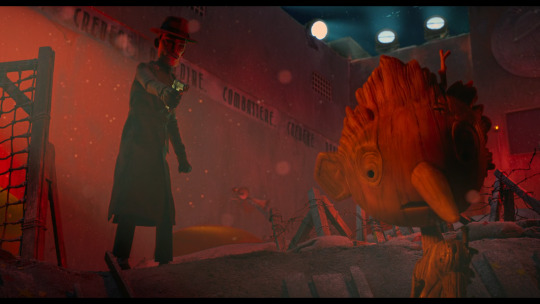
Boy that’s not where I expected this movie to go.
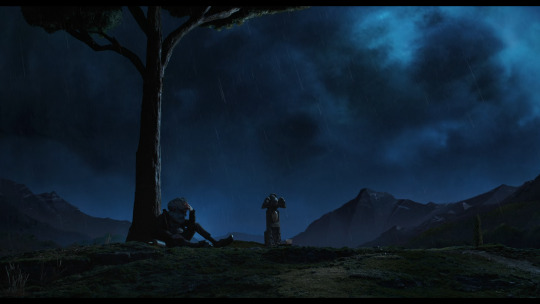
I wasn’t necessarily floored by Pinocchio overall, but I appreciated what a wild take on a staid story it was; the movie’s tone is a big departure, and there are plenty of weird additions / alterations that gave it its own unique flavor. Right from the beginning, Pinocchio’s creation and initial moments are painted with the brush of a horror film: Geppetto carving Pinocchio in a drunken frenzy in the midst of a lightning storm is more Frankenstein than fairy tale, and this is driven home when we get our first look at Pinocchio moving around like an eldritch nightmare, all right angles and reversed joints.
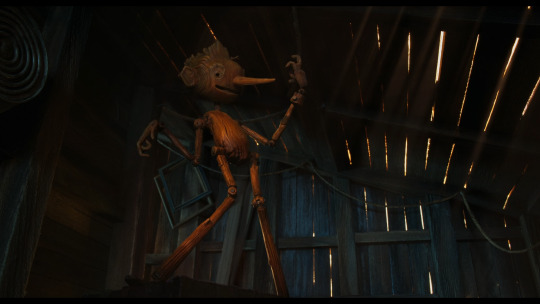
I didn’t care much for the songs, excepting Ciao Papa, which was beautiful.
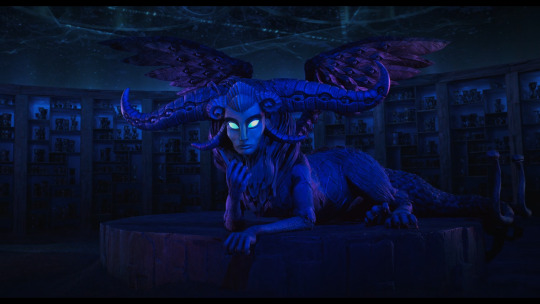
It was also surprisingly gorgeous. I think one of the reasons I put off watching it so long is that I had the impression it was pretty dreary visually, when in fact there’s a lot of gorgeous shot composition and vibrant environments, like Death’s domain.
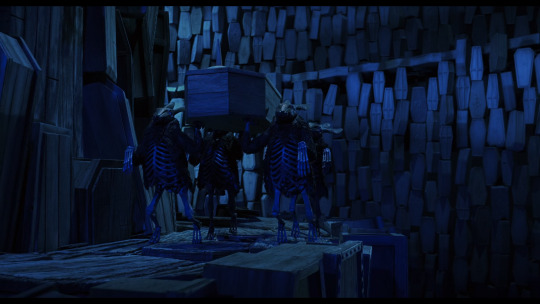
While I thought the story eventually evoked the emotions it was going for, I didn’t feel especially connected to the characters throughout. Pinocchio’s initial wonder was endearing at times (his ‘Wow, I love it! …what is it?’ every time he’s presented with something new), but he’s such a dope for much of the movie it can be frustrating (despite knowing that’s the point, literally born yesterday and all). Sebastian has a strong intro, recounting his illustrious past and scholarly aspirations, but then doesn’t have a whole lot to do for the rest of the movie. Geppetto’s descent into grief and disarray is very clearly established, but he��s still so callous to Pinocchio in the first half that it’s hard to be sympathetic at times.
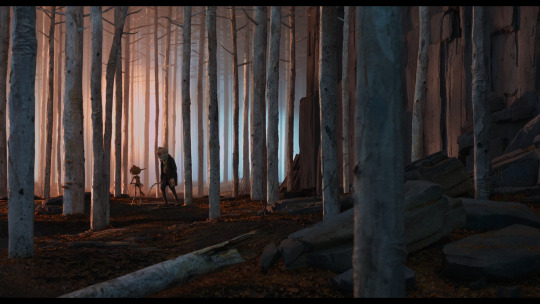
Still, the emotional beats land in the finale, largely through the movie not being afraid to make the proceedings grim as fuck to do so. Pinocchio giving up his immortality to go save Geppetto was a story beat I expected; the execution of seeing a maimed Pinocchio frantically kicking all his limbs and stumps in a desperate bid to get Geppetto to shore, I was not ready for. Then, Pinocchio’s ultimate tragic fate, even though he was brought back to life by a magic wish, is that he has to then go on living while slowly watching everyone he cares about die around him until he’s fully alone, old-school vampire style? Damn, son.
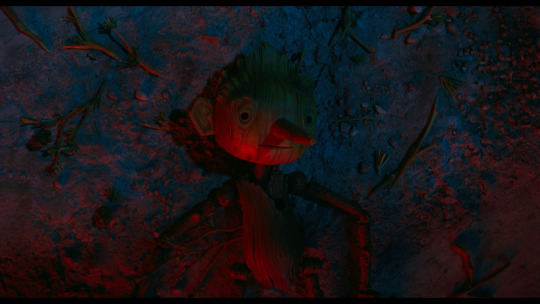
In the end, I have to respect it for taking a story as worn as Pinocchio and making it feel fresh. At one point, I was fully convinced that Pinocchio was about to Inglorious Basterds Benito Mussolini & use his powers as Italy’s immortal ubermensch to fully fork the timeline… how could I not give it some credit for making me type out a sentence like that?
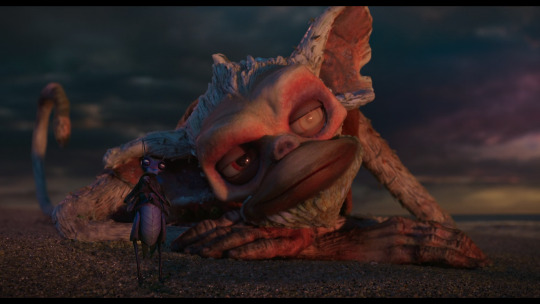
Sebastian J. Cricket, homeowner.
0 notes
Text
The Hunger Games Cinematic Universe
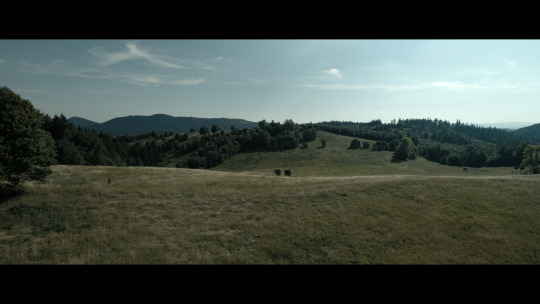
To preface, it does feel a little weird to critique these movies as if they sprung from nowhere. They’re all pretty faithful adaptations, which is relevant because many of my problems with this series are structural / worldbuilding issues, and so aren’t necessarily the fault of the adaptation as much as the source material itself.
On the other hand, it’s pretty easy to rattle off some adaptations that took risks and made something fairly transformative - Jackson’s Lord of the Rings, or anything Masaaki Yuasa has adapted come to mind - so fuck em, they’re fair game.
(I’d seen the first two movies a decade ago, and read the trilogy after that. Ballad and the Mockingjay films were new to me.)
The Hunger Games

Okay, so the original holds up as far as I’m concerned. What sets it apart from much of the post-apocalyptic or action YA that I’ve seen is ultimately how grounded it manages to keep its portrayal of all the kids. I think a lot of fiction with a similar premise tend to falls prey to Anime Syndrome: yes, all the characters are 16 or 17 or whatever, and the authors will make them do some classic teen angst things like get into stupid arguments and be deeply hormonal, but they fail to have the kids react to the horrifying situations they find themselves in convincingly. This is the plight of any battle shounen: the characters are literally fighting to the death against some manner of horrible supernatural monster, or even other human beings, yet will be written like a little devil-may-care badass, or even be stoked about getting to tEsT tHEiR LiMitS! If you’re going for a fun action show, that’s fine, but if you’re trying to sell it as a drama, you’ve already lost your biggest chip.
The Hunger Games (the first one, mind) never forgets that all its characters are young as hell. The absolute shaking terror of the cornucopia, the wide eyed panic as Katniss and Foxface come face-to-face and realize that neither of them wants to do harm, even Cato’s eleventh hour realization that his entire life and persona are ultimately meaningless*, all fill the story with a pathos that makes the movie work, despite some inherent YA cheese.
*Probably my favorite addition to the movie.
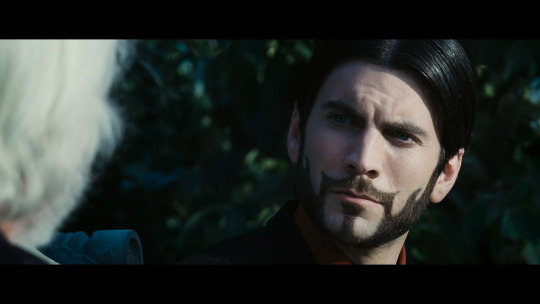
I really love the stupid-ass beard they gave this guy
Catching Fire
Yeah, this is where it starts to fall apart for me. The first act prior to the Games is pretty compelling; our look into Katniss’ PTSD, her and Peeta’s inability to reintegrate into society as if nothing happened, and the acute, sudden horror they’re slammed with upon realizing they’re being forced back into the games are all handled incredibly well. The first half hour of this movie feels like slowly waking up from a bad dream, only to realize you’re still asleep.
After that, though… eh.

I think what bothers me about the Games themselves in this one is that everyone taking part is an adult now. Part of what makes the concept of the Hunger Games so brutal is the age of the contestants - and not merely in a pearl-clutching, oh-jeez-it’s-so-horrible-to-see-this-violence-done-upon-the-youth sort of way. There’s just a special abhorrence tied to watching a bunch of children, who ought to have their whole lives ahead of them, slowly have the dawning realization that their whole world is now this mere microcosm, in which their only options are murder or death. Watching this emotional turmoil play out differently for each character is what makes the setup compelling; horrible, wrenching, but compelling.
So, having the idea for this one be that these grown-ass adults, each of whom has (by definition of being a victor) gone through this incredible trauma before, is willing to go back again and fight like it was the first time? I dunno, it feels goofy to me. And I’m not saying they have a choice to participate - I know it’s mandated - I mean that once they’re in the arena, half of them seem to go “oh well, here I go killin’ again!” like they’re clocking in for a job. It’s not like they’re sliding back into their old psychology by force once they’re in the arena, either - even in the training center, the careers are doing their usual sneering badass routine. You could make the argument that successful careers are the most likely to have child actor syndrome - that they stopped emotionally maturing after the Games and are stoked to be back in their element, Football Player That Peaked in High School style - but that feels so reductive.
I guess the fact that half of the tributes get in on the Secret Rebellion Plan kind of addresses this - they are working toward a goal in the background - but it still feels off. I wish the movie spent more time exploring the mindset of all the contestants before the games started to flesh out their motivations. As is, the Games here no longer feel like blood sport exploring the psychological response to trauma - they’re just blood sport.
Also, the violence feels very sanitized. Say what you will about the shakycam used in the first movie (it is undoubtedly excessive at times), but the confusion it provides combined with the blood makes the 74th Games feel absolutely terrifying. It gives the sense that no one is prepared for how primal things are becoming as the situation descends into a barbaric haze of violence. In Catching Fire, meanwhile, the bloodbath feels like it’s by-the-numbers for everybody - Katniss and friends group up and just start killin’ Bad Guys** right off the bat like it’s nothing, barely even watching their backs as they talk to each other. I read that the director of #2 and on made an intentional decision not to show blood, because he doesn’t like ‘glorifying violence’... I truly don’t understand how showing a bunch of characters cleanly and effortlessly killing other people like they’re in a Marvel movie is any better.
**This is just a symptom of my larger issues with the worldbuilding, but I really think the careers and their motivation get such short shrift in these movies. They explore it a bit in the first movie, but in Catching Fire they’re fully content to have the careers be easy Evil Bad Guys that the viewer isn’t supposed to feel bad for when they die. It’s another touch that betrays its YA roots, and reminds me of Harry Potter - “Welcome to Hogwarts! We’ve sorted you into the evil house for evil, no-good children, which exists because we need to have antagonists.”
This is also where the rebellion bits start popping up, but I’ll talk about those in a moment because…
Mockingjay I & II
…that’s what these entire movies are about and it’s so, so dicey.
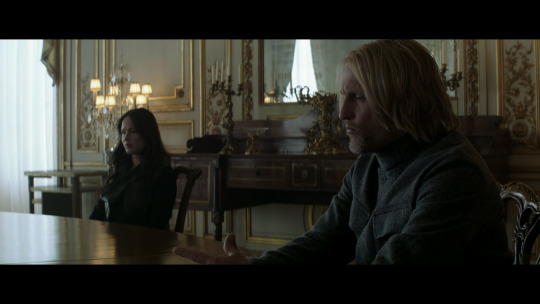
Honestly, to me it feels like Collins had a great idea for a standalone book, but then, by dint of it being YA, was obligated to have the characters eventually band together to take down the big bad Capitol, and just didn’t have a great grasp on how the wider world worked or what a strong revolution story looks like. I think this story worked the best when it was only a small snapshot of the world, with all the periphery implied; the more it’s forced to get into the real nitty gritty of how the setting works, the more ramshackle and unbelievable everything feels, and Mockingjay is where it hits a breaking point. It’s not that there are plot holes, exactly, it’s that we see so little of the wider world that everything feels grossly oversimplified.
I think this is where these films’ dogged adherence to the source material really screws them over. While the books are also lacking in worldbuilding and context from the perspective of other characters, it makes sense there because the books are all first-person POV. Of course we don’t get cutaways to citizens in the Capitol ruminating on their role in all this, or seeing the inner workings of the Peacekeepers to give them any characterization whatsoever outside of being blank plastic suits, because Katniss doesn’t see that. Since the movies have fully done away with this conceit, though, the omission of these supporting scenes feels glaring - especially when the movies are trying so hard to push this theme that everyone has their own fight, and both sides have a reason for their actions.
So, on that note, thematically it’s a fucking mess. It dips its toes into a dozen different themes without really firmly exploring any of them, leaving it feeling indecisive and tonally inconsistent. For example, Mockingjay I spends its intro showing the effect Katniss’ PTSD is having on her, and challenging the idea that just because someone has gone through trauma, they’re a hero and ought to be set up as the mouthpiece of the revolution - how can you ethically put the responsibility of leadership on someone who gets the shakes every time they hear a bang? …but then, not to worry, show her a cool superhero outfit and she’s out there shooting down gunships with fuckin Hawkeye arrows by dinnertime.
And the wider revolution story has many similar issues. What’s your message? Dictators are bad? Wow, what a take. Both sides committed atrocities, so they’re both bad? Politics are hard and messy, and you just gotta keep your head down and hope you can retire to the country? Yeah, way to really take a hard stance on that one.

If I put all that aside, it generally works as a character piece - Katniss and Peeta’s development over the course of the story, in particular, is well done through and through, and it feels rare to see a broad appeal series like have the nerve to take its leads to such dark places. There’s also a lot of surprisingly great character acting throughout; my personal standouts are Hutcherson, Stanley Tucci, and (surprisingly) Woody Harrelson, but there’s honestly not a bad actor in the bunch, which is impressive. Still, with the subject material being so heavy, it’s hard for me just to take it at face value like that, and I wish they shored up the weaker elements a bit.
I’m just saying, if you spend that much of your screentime showing crowds of children being murdered by IEDs, I think you ought to be building towards a strong statement.
The Ballad of Songbirds and Snakes
Yeah, this one felt like a waste of a movie in a really weird way. The execution was incredibly well done - lots of solid acting, production design, etc, which is a huge waste because the basic premise of the movie is fucking worthless.

So, the whole point, I would say, of doing a prequel is to flesh out interesting parts of your universe that you didn’t have time for in the original work. Unanswered questions, a character’s past that you want to learn more about, a deeper dive into parts of the world or lore that weren’t touched on but caught people’s imagination. The Hunger Games series has plenty of gaps that need to be filled: I said above how incredibly small the world seems due to barely exploring any of the capitol, other districts, etc., so it was ripe for a prequel or spinoff! Let us spend some time in other districts, see how other people live and feel about the whole thing. Even if we’re not going post-war, and are going back to the era of the Games (which of course we would), there’s 75 years worth of questions to explore.
Instead of focusing on any of that, the premise of this movie (/book) is “Hey, you know the villain from the original story that seemed like a huge, irredeemable piece of shit? Let’s spend a two and a half hour runtime telling you his backstory, which will show you that actually… he’s always been a piece of shit”. Wow. Spellbinding.
Now, there’s nothing inherently wrong with a main character being a bad person. Particularly, if your character is charismatic, they don’t necessarily have to be right or good to be interesting to watch; there’s a certain magnetism to watching that for a lot of people. It’s never been my cup of tea, to be honest; whether pegged as comedy (Always Sunny) or drama (Breaking Bad), I get fed up really quickly when I hate everyone in a piece of fiction. But done correctly, it can still be interesting - showing how a character ended up where they are, showing you a rare good side of them you’d never seen, or showing that they used to be moral, but just happened to be tested one too many times and fell off the deep end.
Snow is none of these. He’s a piece of shit from the first time we see him, he consistently acts like a piece of shit to everyone around him, and then he ends up, in fact, being a piece of shit***. What’s interesting about that?
***I think the most generous interpretation I could give of his character is a piece of shit who briefly dabbles in transactional friendship after Lucy Gray saves him from the rubble, then shortly thereafter returns to being a piece of shit. Which I still do not find especially compelling.
Even outside of that, it’s one of those prequels that does nothing but make the world feel smaller - rather than expanding on any of the dozens of untouched ideas in the series, we spend a bunch more time in District 12, and show that, actually, it turns out Snow and his hangups are the only reason anything happened in this universe for nearly 100 years. From Katniss’ name to the Hanging Tree song she sings, turns out half the things we learned in The Hunger Games resulted from this one particular guy’s life story. In a series that already felt like the world was too small and was in desperate need of expansion, further narrowing the scope feels like such a misstep.
Why yes, I did need to know exactly what the Kessel Run was!
Odds & Ends
I mostly blocked out my memories of Mockingjay the book from the single time I read it back in the day, because I thought it was booty, but the one thing I remembered liking that they changed up was Finnick’s death. In the book, he’s just there one moment and gone the next, without any fanfare or time to grieve, which serves to make his death feel especially cruel. I suppose it was inevitable, but counter-intuitively, the Big Hollywood Death Scene they gave him here felt a lot less impactful.
-------
A point about the series in general: boy did the costume design bother me. It’s interesting, because all I remembered about it from when this series blew up was the gaudy Capitol style and how crazy the internet was about it. Watching these movies again, I feel like that success was a total fluke, because everything else is goofy as hell. The way that every district has their own bespoke fucking Civil War re-enactment outfits is wild - look, the ‘District 11 is just one big Southern plantation’ thing was always really obvious, but seeing each district dressed up like they're from competing historical re-enactment groups was wild.
The prequel turns this up to 11. I feel like someone on the team though they were real clever - this one’s set 60 years earlier, so let’s make all the outfits and design retro! What? People in flapper clothes, the lake scene with their 1940s swimsuits, even the logo and graphic design in the Hunger Games broadcasting room looking like it’s from the 50s - it doesn’t make any fucking sense. Yeah, they’re set decades before the original books - in the year, like, 2300. What, everyone just forgot how to do graphic design again after the war? Fashion is cyclical, but not like this…
--------
Also, movies 1 and 2 in particular definitely have some uncomfortable racial dynamics going on. I was already weirded out that a lot of the districts seem to be separated by ethnicity, but as you go on, it’s hard to ignore how nearly every Black person seems to exist solely to help Katniss along in her quest before dying horribly and usually on-camera. Rue, Thresh, Cinna, even that old man that flashes the salute in District 11… it’s remarkably consistent.
#will's media thoughts / virtual brain repository#movies#the hunger games#catching fire#mockingjay#the ballad of songbirds and snakes
1 note
·
View note
Text
Tunic

Tunic is clearly inspired by, and aims to recreate, the sense of mystery you have when playing games as a child - you don’t quite know the rules of the medium, you believe anything is possible, and you approach the world of the game with a mindset of curiosity, learning, and awe.
Wonder is a tricky emotion to capture in art; you have to strike the perfect balance of revealing enough to pique a viewer’s curiosity, to get their mind racing to try and fill in gaps and explore possibilities, but not revealing so much that you set hard boundaries and begin to limit the space. I think this is especially true for games. As a child*, games are a land of endless wonder, because you simply haven’t played that many of them. As far as you know, anything is possible: you’re not thinking of things like invisible walls, skyboxes, AI routines, limited possible player actions - you just feel like you’re exploring a virtual world. As you get older, unless a game is really pushing boundaries, or you’re dabbling in a genre you’re totally unfamiliar with, your brain starts to apply time-tested heuristics to understand what you’re looking at: what was once a vast, sweeping city teeming with life, residents and lit-up windows becomes a bunch of big empty rectangles which you know likely can’t even be entered. Now, part of this seen-it-all sensation is likely also due to games as a medium maturing, and certain techniques and design philosophies becoming standards rather than innovations; mostly, though, I think it’s getting older, having more experiences under your belt, and the loss of novelty.
*As someone first getting into gaming, I should say, whenever that may be.

All that to say, it’s an incredible feat when someone can create something that inspires those feelings in even a hard-hearted 30-year old, and Tunic joins the hallowed ranks of Outer Wilds and Return of the Obra Dinn in succeeding in that task for me. There’s a lot of overlap in the techniques these games use to accomplish this feeling:
A lack of overt directions / instructions on where to go and what to do
Trust that the player will pay attention, take time to think about what they’ve seen and read, then draw their own conclusions and make their own decisions
A more open-ended game structure that allows for a player to follow up on what interests them most
Perhaps most importantly, as mentioned before, that exact balance of knowledge and mystery to set a player’s head spinning, while leaving them hungry to explore & learn more. Each of these games has different solutions that create this information gap. In Obra Dinn, it’s the passage of time leaving you only able to pick up the pieces of what happened; in Outer Wilds, it’s the passage of time combined with the vastness of space.
In Tunic, it’s not being able to fucking read.
As someone who’s spent the past 15-odd years more and less successfully trying to learn Japanese, Tunic’s manual system perfectly nailed how it feels to bumble through a piece of media that’s not in your native language. Particularly, Japanese has a weird thing about it where one of the alphabets (katakana) is primarily used for loanwords, and it’s perfectly phonetic. This means that as soon as you learn that set of characters, even if you know hardly any Japanese vocabulary or grammar, you can often pick out one or two intelligible words from amidst the sea of kanji - and usually end up more confused than you were before, because the English that gets used for loanwords is often fucking wild.
If you haven’t had that experience but have played Tunic, it’s literally the exact feeling as opening a page of the manual and seeing:
“?????, ??????????????. ????? THE POWER TO DEFY DEATH ?????, ??????!”
or
“???? ????? ?????? THE HEIR ????, ????????. ????? HOLY CROSS ????, ?????.”
Just say ホーリークロス! ザ・エア!! in your best JoJo voice and you’ve pretty much got it.

Of course, Tunic’s real strength is that it manages to provide that sense of wonder from a multitude of fronts, with clever design and storytelling around every corner. Some of my personal favorite touches:
When you first get (well, figure out how to use) the warp ability, and it immediately lets you warp to areas you have no context for, like the Heir's arena with the giant floating sword, or the closed-off chamber in the Ziggurat
The repeated iconography that you don't question when you initially see it, but which becomes more unsettling with each new instance. The first time you see a Here Lies the Hero gravestone, it makes sense; this must be where the fabled Hero was interred. After seeing like, the 4th gravestone with the exact same statue and epitaph, though...**
After spending hours in-game searching across the entire map for the RGB keys, you trek back to the temple in the overworld, slot them into place, the vast rings sink down, and... nothing happens, the world around doesn't seem to react in any way, and nothing pops up to indicate where you should go next. Love it.
Getting to the Cathedral, seeing the sacred carvings of what appear to be eldritch tentacle monsters, and having no fucking idea how that ties into anything - if that's not a Bloodborne reference, I don't know what is.
**I had a similar ominous, growing feeling with the decoy items that look exactly like your little fox. At first, due to my Gamer Knowledge™, I didn’t question it - surely this is just using my character’s design to make its gameplay role clear, right? By the time I was at the Ziggurat, though, walking through chambers full of writhing, captive foxes, it didn’t feel so harmless finding a little me-shaped doll locked up in a chest.

I think it’s great that even after beating the game and seeking out all the secret content, you’re still left with lots of questions and just enough answers for your own headcanon to start coalescing. Personally, my conclusion is that the denizens of this universe learned they were in not just a simulation, but a game, which is why all of their religious iconography looks the way it does. The obelisks, with their RGB symbol prominently featured, indicate the nature of their reality; the Holy Cross is a technique developed by devotees and scholars that found a way to alter the fabric of their own plane using the sacred geometry of the controller's d-pad. Sure, at its core it’s basically a video game becoming aware it’s a video game - which, you know, has been done a thousand times - but the supremely cryptic, desolate nature of this story just makes it hit different.
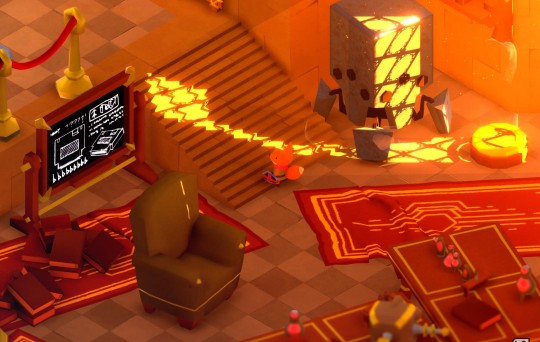
I certainly had my issues with Tunic from a gameplay standpoint. Design-wise, it bothered me that a lot of the level knowledge you learn in this knowledge game is map shortcuts and hidden passageways - only for those shortcuts to be removed in the second half of the game, i.e. right when it would actually be useful again. Also, I was not a fan of the combat. I dunno how to explain it other than just bad gamefeel. Your character’s controls feel relatively loose and clumsy, yet all the bosses can leap across the arena with no endlag, all while having five times your reach. At first, the unforgiving nature of the combat managed to make the world feel hostile and alien, like in a good Souls game, but by the halfway point I was just fed up with the overly punishing fights and wanting to get back to the parts I actually enjoyed. Fortunately, the game does have accessibility options, so I just turned the combat slider down and didn’t look back.
Anyway, while those slight misgivings stop it from being one of my all-time favorites, Tunic is still an incredible game. Years from now, I’m not going to think about my frustration with the lazy boss gauntlet - I’m going to remember the night I spent with my partner decoding The Golden Path, frantically scribbling on pieces of paper like lunatics and awed at the secrets that had been sitting right under our noses since the very beginning.

24 notes
·
View notes
Text
Godzilla Minus One
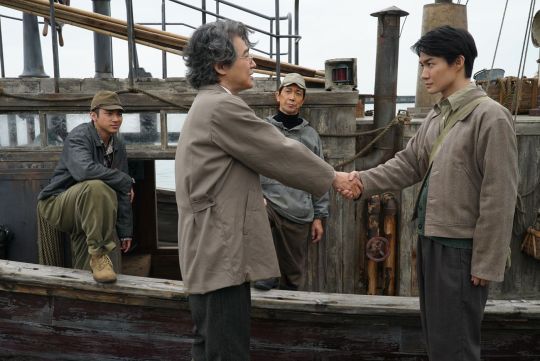
I’ve been going through something of a Godzilla crash course for the past year or so. When I was pretty little, I think I once rented a VHS of the original Godzilla from my local library. I don’t remember almost anything, but I think the themes and talking went over my head and I was mostly disappointed he wasn’t punching another monster. Then, I got a McDonald’s toy of the 1998 Godzilla, which was in my regular school backpack rotation for a while, and... that was about the extent of my experience with the guy.
Two of my best friends, though, are huge Godzilla stans who grew up watching just about every movie that’s ever released. After discovering my innocence, they’ve taken it upon themselves to educate me in his big scaly ways.
Most of these screenings were well before I started keeping this journal, so I don’t have deep thoughts on them. We started with Godzilla Against Mechagodzilla - wasn’t impressed by the robotic human characters, but Kiryu is sick as fuck, no getting around it. Next was Anno’s Shin Godzilla - as a lifelong Evangelion fan, I was really tickled by how much the entire movie felt like an extended, live-action Operation Yashima sequence, and the half dozen remixes of Decisive Battle were the icing on the cake. Final Wars, despite clearly being made by some folks who had just seen The Matrix and wanted in on that action, was exactly my kind of schlock and I honestly can’t wait to rewatch it. Tokyo SOS was kind of forgettable? …outside of the scene where the rival punches a fly out of the air one inch from someone’s face, which I now do weekly. And finally, All Monsters Attack was a wild fever dream of a movie; the plot is about a child vividly hallucinating Godzilla fighting giant crabs and shit in order to deal with his own growth and confidence issues, and that all works… exactly as well as it sounds like it would work. Overall, I’ve certainly enjoyed my time with the franchise, but it’s certainly in a more, I dunno, popcorny way.
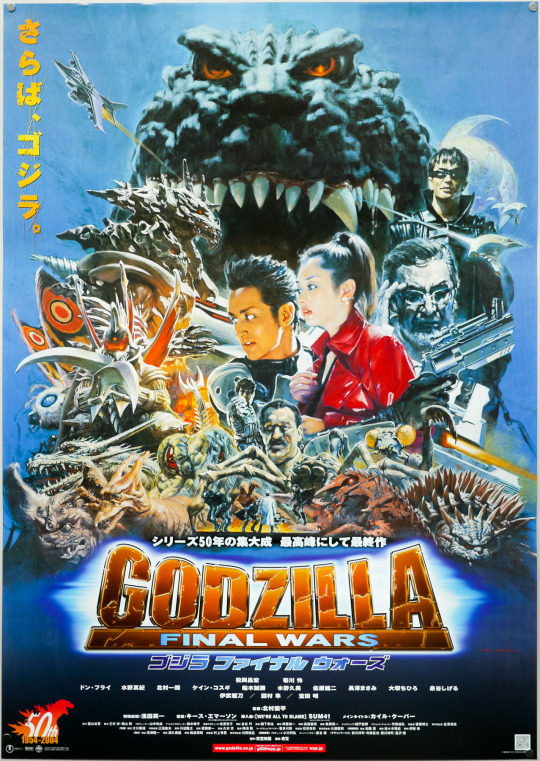
So color me surprised having seen Minus One and being genuinely impressed on all fronts!
This is easily the most compelling human storytelling out of all the Zils I’ve watched. To be honest, during the long gap between Godzilla’s introduction and his reappearance in the plot, I got so fully invested in the characters and the story that was unfolding, it was a little jarring having a big monster show up. The emotional core of the story, based around a found family trying to find meaning in their lives in a devastated, post-war Japan, was genuinely engaging, well-acted, and absorbing. I guess Godzilla being there is what got my butt into the seat, but I honestly wouldn’t have minded a more grounded take on this scenario/era either.

I quite liked that Godzilla’s design in this movie felt focused around his aquatic habitat - he felt very lithe, crocodilian and deadly in the water.
Similarly, after spending so much time digging into the hopelessness felt at large by the citizens we see, and the widespread devastation of Tokyo after the firebombing, Godzilla coming in and attacking Ginza felt like a gut punch. Typically, in the Godzillas I’ve watched, at least, the moment where Godzilla finally shows up and wrecks shop is a moment for the audience to cheer. You recognize that the horror and destruction he’s wreaking is bad, of course, but for one reason or another the blow is usually softened tonally. In Shin Godzilla, for example, we watch plenty of montages of Japan’s well-oiled, calm evacuation plans being carried out, so we’re not worried as much about the human toll. In the more creature feature entries, like Tokyo SOS, these type of scenes are more WWE throwdown than human catastrophe - the city’s really just backdrop, and it’s time to get hype. Minus One even has some moments like this, in my opinion - the scene when Godzilla first engages the battleship and they cut off his iconic roar has strong “real done with your shit” vibes that make the film’s debut atomic breath a real crowd-pleaser.
But man, the Ginza scene? Absolutely devastating. Panicked, weary crowds, scores of people visibly trampled underfoot, the black rain calling back to Japan’s nuclear strikes… the entire scene is designed to be a nightmare, and I thought it was a powerful decision in a franchise movie to make the viewer squirm and wish the titular character hadn’t shown up at all.

“Godzilla, bro, look. My job? The job I’m working to feed this orphan who showed up on the doorstep of my dead parents' house? That job is shooting active mines out of the ravaged coasts of my country on a fishing boat at great personal risk to myself and my only friends. Did we really need this? Was this warranted? Could you just like, fuck off?”
Overall, I just can’t get over how strong the character work and theming was. There’s a lot of musing on the value of a life, survivor’s guilt, and people grappling with the aftermath of a lost war while figuring out how they can still make a difference in their community. In the opening scene, you can already tell from the conversation between the main character and the engineer that they both understand the war is over, and yet Shikishima carries guilt with him the entire movie about not committing the meaningless sacrifice his country asked of him. He’s absolutely wracked with guilt, feeling that he’ll be rejected by society for failing - and to a degree he is, especially in the first act. After that, though, time and time again, the movie shows a community coming together, refusing to let each other give in and succumb to guilt, and finding ways to rebuild their home and move forward on their own terms, rather than under the direction of a government that's abandoned them.
The standout scene for me was Shikishima’s trauma coming to a peak when he wakes up at night and questions if he’s been dead all along, wondering if his current life is just a hallucination. I feel like I’ve seen that exact scene or moment in other media before, but it always felt like empty words, unconvincing; here, the buildup and acting was just so stellar that I fully resonated with this broken man and bought every word.
8 notes
·
View notes
Text
Little Miss Sunshine

What a pleasant, wholesome experience. This was a household standard when I was growing up, but I hadn’t seen it in ages - was glad to come back to it and still enjoy it with fresh eyes.
I really love the bespoke score composed for the film. I think typically, there’s something about road trip movies that inspires an even more heavy-handed use of licensed music than usual. Even for a more dramatic movie like this, which doesn’t shy away from heavier topics and treats its characters with a lot more nuance than the usual pastiche, I could easily see another timeline where this is filled with your highway classics, or classic country / Americana vibes, to guarantee certain emotional beats land as intended with as little risk as possible. Instead, the score adds a very unique and consistent character to the proceedings. It goes between a few genres, but I’d almost call it… a sort of acoustic folk post-rock? There’s lots of accordion interludes and spaghetti western motifs, but at the core of all the tracks are these layered, building, interlocking melodies that call post-rock to mind. It’s great, anyway.
Olive and her grandpa completely steal the show, obviously. The film absolutely hinges on the character of Olive, and Abigail Breslin’s work in the role is one of those performances that’s so perfect and unlikely that it feels like they placed a bet on her and won. The character of the grandfather, likewise, is compelling and filled with heart. Every time you think he’s just falling into the irascible, out of touch old man who doesn’t care about anyone around him trope, he’ll show such gentle, sincere empathy in a situation that you can almost imagine the character’s whole life leading up to the movie.
Man the dad fucking sucks though. That’s kind of the point, I know, but I feel like the movie really tries to set him up for this third act redemption arc, and I absolutely do not fucking buy it. Look, he spends the whole movie fat shaming his seven year old daughter and giving her complexes she’s gonna spend decades unraveling - am I really supposed to think he’s turned over a new leaf just because he’s suddenly willing to commit crimes for her at the end? Like, shit, dawg, when you get pulled over and arrested for smashing through the fourth pay gate in a row it’s not gonna be so cute anymore. Puttin’ the whole family in danger to try and show character growth and shit..
Who’s the loser, now, Richard??
1 note
·
View note
Text
Honkai Star Rail
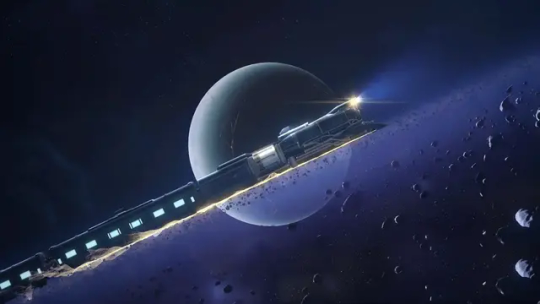
Honkai Star Rail is Cookie Clicker with anime girls.
I mean that with all the positive and negative implications that brings.
That is to say, I love it.
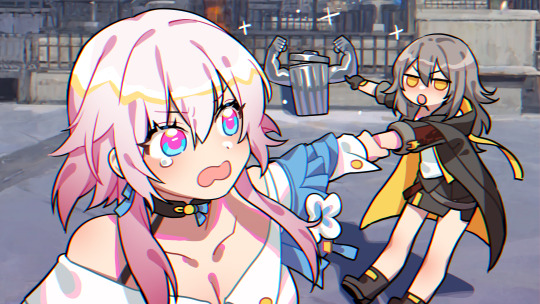
art by CHAROMO on pixiv
Honkai Star Rail features bespoke dialogue for every single trashcan you can interact with, which I consider a culturally significant feature.
---------
“As you continue staring at the trash cans, they seem to turn before your very eyes. The edges are no longer rusty and the dents are smoothed over.
From under the lid comes a faint golden glow, sweet and alluring.
For a moment, the trash cans turn into treasure chests.
March 7th: ...And it's happening again.
You take a deep breath and open the lid: it's empty...
Wait! You reach deeper into the trash can. There's a piece of iron scrap on the bottom. Your hard work paid off! You finally found the treasure!
You look back at your companions and see their complicated expressions.
March 7th: ...You don't need to explain. I get it. That urge is too great for you to resist.
Dan Heng: There's no turning back once you've walked down this path.”
(This is a metaphor for me playing this game)
---------
“An overwhelmingly fishy smell emanates from the trash can as you remove the lid. Instead of fish, you find only a fish-related flyer. Is this how synesthesia works?”
---------
“The inside of this trash can is good as new. You've never seen a trash can this clean before...
In fact, you've never seen anything this clean before. This trash can is like the universe's very incarnation of purity... Maybe we're going too far.
-> Stroke the trash can.
You stretch your hand out and gently stroke the trash can. A soft, tender, smooth, unconstrained, and tactile sensation travels up your fingertips...
You feel a great sense of satisfaction — like that of some fairy tale princess who's just woken up from a night's sleep on nine mattresses stacked on top of each other. All concern, exhaustion, and sense of duty fly away...
There's no doubt about it, this is the world's most beautiful trash can.
-> Investigate carefully.
You take a good look at it. The inside of this trash can is dust-free and perfectly dark. It's the kind of pure darkness that surrounds IX in a nebula of dark matter.
It focuses your attention, and your eyes become fixed on it... You see yourself. You see March 7th and Dan Heng. You see the fate of the Astral Express and the end of the future...
You force yourself to stop staring and everything disappears. It feels like a fantasy dream.
-> Close the lid.
Only you know how much courage it takes to avert your gaze from the world's most beautiful trash can.
March 7th: What's up? What's in there? What's with your expression?
"Nothing," you decide to tell her.”
---------
“The trash can glared coldly at the other trash can gasping for air at its feet. "I told you, Melnyk," it said. "I told you that you will one day collapse beside me. When that time comes, I will laugh to your dying face. Such is the wind of change."
A goo of darkness dripped out of the dying trash can's form and continued to snake its way forward. It looked up at the cold eyes of the other trash can. Fifteen years had passed since it had last seen that gaze, when the standing trash can was still tiny.
"It's me..." the dying trash can bade, "I was the one... who raised you..." A wave of sharp pain enveloped it. At that moment, it realized that a certain trash bag had burst. The shooting pain coaxed a whimper out of the dying trash can while the other one snickered satisfactorily.
It crouched down and whispered a name in the ear of the dying trash can. "You—" The trash can's eyes was wide open. "But— No, you can't be..." Its final words curdled inside its mouth like the teardrop hanging from the corner of its eye.“
---------
(This one isn’t a trash can, but a closet in your hotel room you can enter.)
“->Go inside the closet.
Without a doubt, what's in front of you is a closet.
It is — based on all the signals coming in from your sensory organs — a perfect closet. Design, capacity, tactility, build quality, and scent... No matter how you look at it, you can't possibly think of a better closet.
Wait a minute, scent? How is scent a measurement of how good a closet is?
Doesn't matter. It smells good. And it's not an odor of typical sandalwood or any other natural materials... Rather, it is a miraculously cleansing scent that is completely artificial, a marvel of chemical engineering. It is so alluring that all you want is to get into the closet and let your whole body soak in its scent.
-> Whatever, I'm going in. Here I come, closet!
Yes... you are about to go in!
Left foot... Right foot... Turn around... Take a deep breath... Darn it, why a deep breath? You wanna sneeze, but manage to suppress it... Stand firm... And then...
...close the door in one smooth move. Bang!
Congratulations! You've now been merged with the universe's most perfect closet as one single entity."
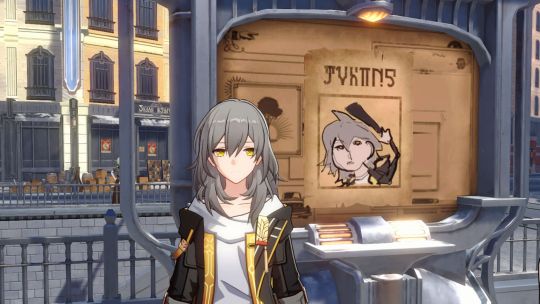
4 notes
·
View notes
Text
Scott Pilgrim Takes Off, and also just Scott Pilgrim
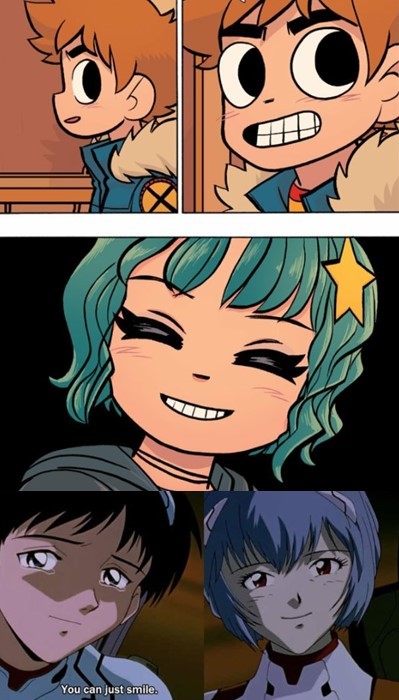
-footage from Rebuild of Scott Pilgrim
I watched Scott Pilgrim Takes Off, then realized it had been nearly 15 years since I actually read the comics, so then I re-read all of those. I wish I had just done it in the right order to begin with, because doing it this way really scrambled my thoughts about both works. In my defense, how was I to know Takes Off is actually a sequel? What am I supposed to do, read things?
I was pleased to find that the original Scott Pilgrim honestly holds up pretty well. Takes Off is clearly such a reflective work that I was expecting to find the original story a lot more problematic than I had in high school, but… for the most part, it really knows what it’s doing. Yeah, a lot of the characters are shitbirds, but they’re meant to be shitbirds. The entire point of the book is showing us flawed people who intermittently make shitty decisions, and giving them a chance to grow, reflect, and treat the people around them better.
So generally, I still really liked Scott Pilgrim. All the goofy-ass character art and the surreal, unexplained quasi-fantasy Canada bits that made it tick back then still work. This time around, I really appreciated the writing and dialogue for not only its bevy of solid jokes, but for how fucking weird it is. In the past decade or so, I think a lot of ‘quirky’ humor has homogenized somewhat into a particular tone. Call it Whedonization or globalization or internet brain or whatever you want, but it can sometimes feel like anything aiming to be comedic hits a lot of the same beats.
The Scott Pilgrim comics, however, are a weird time capsule and their own vibe entirely. These fuckers just talk like aliens sometimes. They say random stuff, but it’s not *holds up spork* random, it’s “shit sorry I was kind of half listening but I think the thing I’m about to say is relevant” random. It’s less big swings to try and land a punchline, and more of two people letting loose a stream of consciousness at each other, lending a sense of constant confusion to the proceedings. It’s absolute nonsense sometimes, and I was way into it.
This ties into a slight shift in my read on Scott as a character, too. I always just saw him as a huge asshole - and that led to my biggest issue with the movie, which was that Cera plays him way too meek and doesn’t suck nearly enough. Reading the comics again, though, while Scott absolutely does suck, he’s just so fucking head empty that I warmed up to him a bit more. He’s still an asshole that doesn’t take responsibility for how his actions affect others, absolutely, but also god damn he’s so dumb that it softens the blow sometimes.

There were some little details about characters I’d forgotten that I really love - like the fact that Scott is actually a really good cook, but does it purely through intuition without knowing what anything’s called.
Art-wise, I liked it a lot more than I remembered, too; it definitely starts out a bit rough, but there’s a lot of charm to the characters and their weird gremlin mouths. I also laughed at some of the manga inspiration I didn’t pick up on before; everyone’s got big anime eyes, sure, but the grey screentone Clip Studio pattern fills? The hiring of assistants to do polished background work as the author gets into the later volumes? Ahh, classic.
Takes Off was a lot of fun, too. I gather that a lot of the internet fandom is upset it wasn’t a straight retelling of the original story with killer animation, but man, you gotta let creators create what speaks to them. Bryan Lee O’Malley started Scott Pilgrim twenty years ago. He’s been both married and divorced since then. Surely he’s gone through as much growth and change as we all would in such a timespan - how could you expect someone to just re-tread the exact same ground on such a personal story?
I find it interesting how prevalent this trend has become in the past decade or so - a creator or creative team returning to an old work - seemingly out of necessity, as the IP has become such a juggernaut that it’ll happen with or without them - and refusing to just tell the story again by the numbers. Anno’s Rebuild of Evangelion is the closest spiritually to this, but even recent ‘remakes’/reboots like Final Fantasy VII and God of War 2018 have followed the same path - creators ruminating on the strengths and weaknesses of older work from a more distant lens to create something new. They all seem to have arrived at this methodology independently, too (O’Malley said he only watched the Rebuilds once Takes Off was written and well underway); it’s not about chasing the trend of an altered remake, it seems to just be a natural desire to reckon with the past this way.
Because of this, one of the reasons I really wish I watched the show after re-reading the comics is to have a better sense of the evolution, and the change in tone and message. Due to watching Takes Off while having only a hazy recollection of the original, I made a lot of assumptions about how the original work must have portrayed things, to explain what Takes Off’s themes were a rejection of: that by giving Ramona more agency, she’s less of a damsel in distress/prize to be won, and isn’t defined by her body count… when in fact, neither of those are really the case to begin with. Ramona has plenty of agency in Scott Pilgrim, she fights as much as Scott does, and really is only defined by her body count as narrative framework, not judged in-universe by the other characters* **.
*I think some of these misconceptions may have come from having rewatched the movie more recently than I read the comics, as the movie (if I remember correctly, which this entire blog has established I likely don’t) does tend to treat Ramona as more of an passive object. Her subservience to Gideon in the real world (rather than in her subspace mind prison) comes to mind.
**Also, you could argue that the framework of the story itself being ‘guy fight’s girl’s evil exes in order to earn the right to date her’ is inherently placing importance on Ramona’s body count and someone’s romantic eligibility/desirability being defined by that but like… man that just is clearly not the vibe imo
If anything, I think the real lack that the show was trying to make up for wasn’t Ramona’s lack of agency, exactly, but a lack of screentime. Takes Off simply spends more time inside Ramona’s head, letting us see things from her perspective, and understanding the reasons for why she is the way she is and why she does the things she does. In some volumes of the book, she’s aloof almost to the point of feeling like a trope; it’s clear (especially later on) that there’s a reason for the way she acts, but the story just doesn’t necessarily communicate it very well. In the show, with Scott sidelined, we get to spend a lot of time with Ramona, understanding her thoughts and feelings, which is certainly a welcome change.
Anyway, intentions of the changes aside, I wouldn’t trade Takes Off for a straight remake in a thousand years; the sense of utter surprise I felt while watching the story take a hard left turn was exhilarating***. Plus, if the reason you love a series is the characters you’ve developed a bond with, what could be better than canonized fan fiction written by the original creator, showing your favorite characters interacting in new and novel ways? How could one not be excited to see Gideon and Lucas bro out and watch anime together? How could one not be thrilled to see Wallace Wells enact further chaos upon the whole province? More than righting storytelling wrongs, Takes Off is making space to tell more stories and round out everyone’s favorite supporting characters in a franchise that, due to the inherent density of its plot and setup, simply hasn’t had the real estate to develop all of them and let them breathe.
***Having just played through NieR recently, I almost felt like the show had scanned me, detected I had gotten Scott Pilgrim Ending A before, and was throwing some NG+ bonus content at me lmao
As far as the production goes, I was impressed overall, but thought it did suffer from some awkward timing and pacing issues. It’s stiff competition when your inevitable point of comparison is an Edgar Wright movie - even other live-action movies can seem stiff and slow compared to his frenetic pacing and constant cuts - but it still felt remarkably low energy at times, especially in the back half. Now, this is a problem you see a lot in anime dubs; English and Japanese are two very different languages, with different cadences and construction. Since a cast is typically required to dub over already existing animation, the translated dialogue often ends up being elongated and unnatural when it should be a quick back and forth, or hurried where it should have a little more breathing room. Given, though, that Takes Off was not only recorded in English before Japanese, but actually recorded before animation then animated to the dialogue (exceedingly uncommon), I was surprised the show still had this issue.
Regardless, the boarding in the first 4 episodes or so manages to be bombastic enough that this isn’t a problem; there’s a lot of wild camera angles and perspective shifts that keep things dynamic even when the dialogue itself isn’t moving too quickly. The animation highlight for me personally was the fight in the video store between Ramona and Roxy; great idea, incredible execution.
While Science Saru is the main production studio, I was intrigued to spy a bunch of other studios listed in the credits - WIT, Shaft, Ufotable, Trigger - but upon some further research it looks like they were just doing inbetween work.
Also the music includes slapped - I was jamming hard to Kidnapped by Neptune and Konya wa Hurricane, and then that United States of Whatever drop? unreal.
#will's media thoughts / virtual brain repository#shows#comics#scott pilgrim takes off#scott pilgrim
7 notes
·
View notes
Text
The Lord of the Rings 1978

Okay so this was pretty terrible but god DAMN did the background artists go hard.
Look at how fucking brutal this is!

In particular, I thought the way elven architecture and spaces were portrayed was a truly inspired decision. Nine times out of ten, elven concept design goes for the sleek, clean, minimalist look with lots of gold filigree, muted palettes, and grand sweeping arches. Honestly, lately, this is probably due in large part to Peter Jackson’s own Lord of the Rings capturing the public’s imagination, but regardless of origin, the aesthetic is incredibly pervasive. Now, I get it - it makes total sense, right? It’s an effective contrast to show a younger race like humans getting by with rustic, utilitarian dwellings and cities while elves live in effortless, minimalist grandiosity. It shows them as being not just a step ahead aesthetically, but as if they’ve gone through entire epochs of design. It suggests a deep history, and a careful refinement of culture and craft - it’s thematically resonant as fuck with the narrative role elves are usually filling. Thus, the ubiquity.
So seeing something go all the way into left field with this shit, I was enamored.


In Lord of the Rings 1978, Rivendell is a fucking trip. All of the halls and rooms are typified by almost psychedelic excess, with patterns upon patterns and splashes of vivid color adorning everything. Huge, looming statues are ever-present, lurking behind the characters like watchful gods.

In the outdoor council room, things have descended into madness. We’re not even getting full figures anymore - faces conjoin as they emerge from cold stone, headless bodies entwine even as they lose the finer details of their form, curves become mere suggestions of limbs.


The traditional elven aesthetic implies that immortality drives one to an obsession with perfection. It’s not about quantity, it’s about refinement: they build and rebuild, honing their craft and pushing a design’s evolution until it is flawless. There is not a line or angle out of place; every piece is in concert with the whole, in a way only a society of hundreds of centuries-old master craftspeople could successfully do.
Here, on the other hand, is an ethos and style almost Slaaneshi in its excess. Why stop at one elegant, perfected form, when instead every nook and cranny of the space can be filled with extravagant beauty? With an undying society and few needs to meet, every citizen can be an artisan and contribute to a staggering visual assault that finds continuity in its lack of uniformity. They can simply add more, and more, and more, until there is not a single bit of space left for more embellishment.
I would like more of this, please.
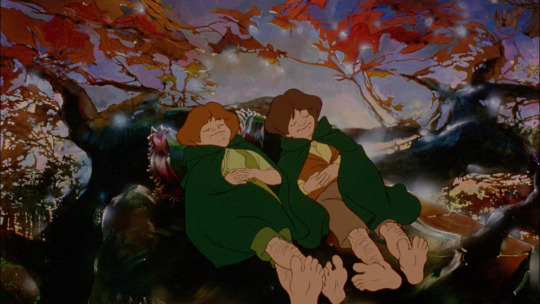
Anyway, anyone who says Peter Jackson’s trilogy is all running should watch this movie, holy shit. Uninterrupted minutes, I swear to god.
Also, there was a man in the credits named Aesop Aquarian, which I thought was important.

#will's media thoughts / virtual brain repository#movies#the lord of the rings#lord of the rings 1978#lord of the rings
3 notes
·
View notes
Text
About Time
Short one here - downloaded this during the romcom week but watched it later.

blech.
The second half of this was a lot more thematically interesting, but the first half (the rom-com bit) was so skeezy I just couldn't get over it. Using time travel to fix your romantic mistakes with someone is inherently a weird, imbalanced power dynamic, and I thought it was strange they made the movie about that without really addressing the ethics at all.
The leads' first meeting, where they have natural conversation, learn about each other and build rapport in the lights-out diner? Great, love it. The second time through, where he comes up on her like a stalker, creepy as hell, telling her things about her hobbies he shouldn't have any right to know, and her rolling with it for some reason instead of running away? Awful. Him using the time travel to repeatedly have sex with her in different ways without her knowing about it? What the fuck, man...
I thought it was really telling that neither the main character nor his dad ever even consider or discuss letting their spouse in on their ability. Subconsciously they / the writers clearly understand it's a violation of privacy, even if they don't talk about it.
Bill Nighy was great though, and I loved the relationship between him and Gleeson. I wish the movie was all about that, or about Tim using his power to help people (like with the play), instead of trying to push a message about appreciating the little things in life after making us watch the main character be a fucking sleazebag for a whole hour.
0 notes
Text
Death's Door

Recently, I listened to Band of Skulls’ Himalayan for the first time in a while. Though it’s by no means top tier for me compared with the entire oeuvre of music, I’ve always quite liked it. There’s about three more plodding ballads than I’d prefer, but there’s no denying the groove on songs like the title track or 'Asleep at the Wheel'. What really struck me on that listen, though, was an issue of timing. As I listened, I couldn’t help comparing it to the classic 70’s rock and blues it’s inspired by, and the interesting thing is - it stacks up. I’m fully convinced that if Himalayan dropped in 1971, Band of Skulls would stand among the classic rock pantheon; the riffs, the swagger, the catchy vocal hooks, it’s all there. Play it next to a Cars album, and it hangs. Thing is… the album came out in 2014, so it’s just another drop in the bucket.
All art is inherently tied to the era it’s created and released. Art isn’t made (or viewed) in a vacuum; it’s the summation of all of a creator’s influences & inspirations, and a reaction to the contemporaneous art being made around them. Normally, creators are working within the mold of their peers, with perhaps one solid fresh take or angle to put in, and end up creating work that is Good. The ones that are remembered and referenced decades later, though, are often the works that take a big swing, that take a big leap forward, and are different enough that they not only stay in the public consciousness, but have an outsized influence on the art and artists that come in their wake. We’re talking your Star Wars, your Evangelion.
Due to the constant progression of style and medium, of course, it’s common for one to go back to works like this and be underwhelmed - as TV Tropes puts it, the ‘Seinfeld is Unfunny’ effect. This happens when a work is so influential, and so much other art is derivative of it, that the original itself seems uninspired and doesn’t quite live up to the cultural hype - and, since it was the first of its kind, it’s often rougher around the edges and less refined than the works riffing and iterating on it. I’ve run aground of this many a time when going back to classics, to varying emotional responses: while I take some weird, anti-boomer pleasure in thinking the Stones are boring as fuck, there’s also a part of me that weeps for the deep ambivalence I felt after reading Akira for the first time. I’ve even gotten this feeling when revisiting a work that I loved back when it was fresh: Bastion set the indie world on fire back in 2011, but a revisit in 2022 left me cold.
(as a friend put it, Bastion walked so Hades could run… but going back to that pace is tough.)
The other end of this spectrum, then, is a work that is almost… the endpoint of a certain style, as set in motion by one of those classics. A work created by people that have seen what started the subgenre, that have seen the work that was inspired by it, that have read decades of criticism and know what works and what doesn’t. A work that, conceptually speaking, is playing things about as safe as it possibly can, but is absolutely nailing everything it goes for on the technical level. It shows a deep understanding, even reverence, for what came before, it speaks to a mastery of craft, and to a deep polish and sense of perfectionism. This sort of work isn't attempting to break the mold; they know exactly the type of work they want to emulate, and are just doing it exceptionally well... if about twenty years late. This, to me, is Himalayan, and, as you may have guessed by this point, this is Death’s Door. The unfortunate thing is, where Himalayan’s humble confidence always lands for me, Death’s Door left a lot to be desired.
There should be a lot to love here. The visual design is sharp, with a cool macro lens effect and well-defined shape language. The locations are varied and distinct, while keeping to a consistent palette. The controls are responsive and intuitive. The music is pleasant. The game runs well, and doesn’t have any huge design snags or difficulty spikes that leave it feeling undercooked. It’s just… that’s all there is to it, really. It’s all very polished and well done and dull.
Playing it just feels like going through the motions. There’s this big world, but despite being a crow, you don’t really have any interesting movement options; you’re just slowly running from place to place, and there is a non-trivial amount of backtracking to do. I put all my points in the game’s upgrade system towards movement, just so I could get from place to place marginally faster. The combat is pretty average; its risk/reward projectile system is reminiscent of Hyper Light Drifter. There’s not many mix-ups or options; you have a sword, a dodge, a projectile. You get new weapons, but they’re more or less stat changes. You have upgrades, but they’re pretty unnoticeable percentage stat boosts. None of the enemy designs are particularly compelling* or difficult, and challenge is largely increased by throwing out a bunch of them at once, or in repeated waves.
*I will give the one exception here to the Urn Witch fight, which was chock-full of interesting patterns and give & take.
There’s not even really puzzles, per se. There’s ways you interact with the environment to proceed, sure, and you get items that let you access new areas, but it’s more like being a rat in a maze than anything else. You enter one of the labyrinthine areas, and the way forward is just to make sure you’ve gone down every corridor, pulled every lever, and used the right projectile for each obstacle. You can usually see everything you’ll need to do when you enter a space, you just have to perform the rote actions necessary to proceed in a way that isn't particularly interesting or satisfying.
One of these moments is the exact point where I mentally checked out of the game, during the Flooded Fortress level. You’re walking along a long series of docks and fortifications, occasionally loosing an arrow at a pink button to open the way, but mostly just ambling down a long, winding pathway.

And then, you come to this gate. You’re coming from the path to the top, and you need to get up those stairs and through the gate, but the gate is closed. See that lever, just below the gate? That lever opens the gate. So you walk around the side of the gate, pull the lever, the gate opens, and you can then walk back and proceed through the gate.
What the fuck? What is this? Is this supposed to be a puzzle? Is this gameplay? What are we doing here?
...
Speaking of labyrinthine areas, hot damn, this game could use a map. The levels are sprawling, and while there’s a lot of visual variety between the different areas, each area itself is sorely lacking in landmarks and waypoints. The cemetery hub was the worst offender; every time I had to go back there I had a sense of dread, despite there being literal signposts littered around. I also felt there was precious little actual worldbuilding for how much the game seems to want to be a tone piece. The levels are certainly themed and attractive, they just feel more like levels from a PS1 platformer, using the theme as set dressing. It’s another context situation: fifteen years ago, this level of polish alone would turn heads, while today, I compare it to Hyper Light Drifter’s fabulous and enigmatic environmental storytelling and feel it coming up short.
Death’s Door has its charm. I love the lil spirit guys that line up and follow you around. They did a great job with the main character’s idle pose, how he just twitches around doing bird shit. I thought the furnace sequence, with the pistons synced to the frenetic music, was a memorable standout. Some of the dialogue and characters are great; shout-out to the crow in the main office that just fucking CAN NOT get enough paperwork, like just could not be happier the more monotonous typing she has to do. Keep thriving, queen.
My favorite idea is how you hold a funeral for each boss after defeating them. I’m sure this ties into some of the game’s ruminations on the role of death as the game goes on (I’ll never know, I quit after the Frog King), but it’s just such a novel thing to do. How many enemies do we slay in any game, how many bosses, how many people with names and backstory and motivations do we cut down, and how rarely does a game take a moment to acknowledge their passing? This is obviously not the first game to explore this idea - look at Shadow of the Colossus, hell, I just played through NieR, and I’m sure this has been done before I was even born. But the simple mundanity of having you and the other NPCs gather around and say a few words about some big fuckin frog you just beat to death lends a fascinating sense of gravity and normalcy to the proceedings.
Well, let me pay my last respects to Death’s Door, then. If you came out ten years ago, you would’ve blown everybody’s fucking mind, I’m sure.
0 notes
Text
Scavengers Reign
Holy shit, good western animation that’s not comedy and actually has a focus on aesthetics, setting and craft??

Seriously, I still can’t believe something like Scavengers Reign got made. This feels like a student thesis film you’d see on Vimeo, not a full 12-episode series with a healthy production schedule.
I loved this show. The artstyle is a clear rip of Moebius, but that’s… fucking sick? I mean, given how little that style has been successfully adapted for animation, I’m all for it, especially when it’s done with this much care and skill. Seriously, some of the longer environments shots could genuinely pass for later Moebius illustrations. The colors are also gorgeous throughout, managing to make each biome feel distinct (and thus sell how far our characters have traveled) while maintaining a consistent, muted vibe over the course of the story.

The star of the show, obviously, is the ecology and creature design. Even with no added context, the designs are all very cool, from the little rolling polyps we see everywhere to the stampeding ungulates. But the thing that sets this show apart is the clear ecological niche we’re shown for each species. Nearly every creature we see, we learn something about: their source of food, their natural predators, the unique behavior they’ve adapted to thrive in their environment.
And the comparison to nature documentaries doesn’t just stop there - they even directly ape the style, editing and content of documentaries, like when the show focuses on territorial disputes between members of the same species, or highlights a predator taking advantage of its prey’s weakest moments to strike.
Some of my particular favorite ideas:
1. All of the various white-coated creatures near Azi’s desert encampment that blend seamlessly into the spires for camouflage
2. The seafaring creatures sucking up their young for protection during the lightning storm, and the parasites that come in to gorge themselves while they’re defenseless
3. The fact that the little Grey-looking gecko-apes (Hollow’s species), given their intelligence and powerful telekinesis, could clearly become apex predators and take on prey many times their size… but instead use their hypnosis to force other species to get food for them, because it takes way less energy expenditure. That’s nature, baby!
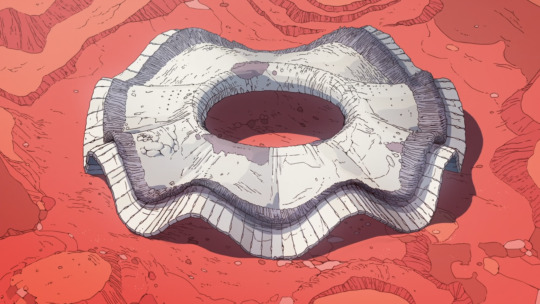
The show definitely drags a bit around the halfway point. The start of the story is explosive, as we follow the viewpoints of 3 different groups of survivors and their drastically different situations. The character dynamics are great in the beginning - Ursula and Sam’s early mastery of the wildlife during their expeditions, Azi’s reticence contrasted with Levi’s developing personality, and the slow horror that unfolds as Kamen is taken in by Hollow. For the first few episodes, we have no idea where things will end up, and it’s exciting watching things play out.
By the midpoint, we’ve basically lost Kamen’s point of view, as his arc is put on ice until the end of the show, so we’re just bouncing back and forth between Sam & Ursula’s perspective, and the group Azi finds herself falling in with. Sam & Ursula’s narrative feels like it gets stuck in a rut here, as Sam gets infected with two different parasites back to back; I really feel like they should’ve committed to one (preferably the plot thread about the previous survivor) rather than trying to land the same emotional beat twice in a row. On Azi’s side, while I understand what they were going for with Kris and the other newcomers, their story never really got compelling for me. Scavengers’ strength is the planet and its bizarre alien life. Levi, with their dawning sentience and growing connection to the natural world, really fits into those themes; replacing that with a ‘Humans were the real monsters scavengers all along!’ subplot is a tough sell, especially when the characters driving it are about as charismatic as a puddle and have some of the most awkward acting / writing in the show.
There’s even some form issues in the middle section. In classic anime fashion, the visuals take a bit of a hit; there’s less standout background work in the 2nd act, and the character animation suffers at times. I also found the editing distracting in this section; with only two points of view to go between, the constant cutting between the A and B plot started to feel artificial and distracting. Also, since we more or less have an idea of how the stories are going to come together by this point, there’s a sense of inevitability to the proceedings.
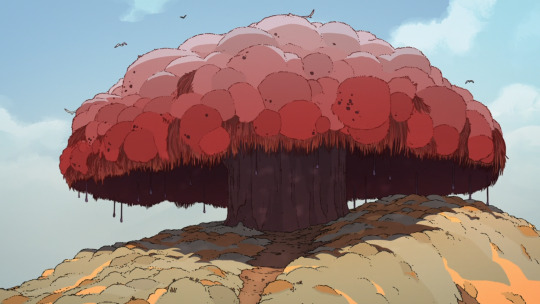
Fortunately, things come back together in the end; Ursula leaving Sam behind is every bit as bittersweet as it should be, Levi’s resurrection by the planet-flowers is fascinating, and the sequence where Hollow is returned to its natural self, courtesy of a Levi-supplied Total Perspective Vortex, is just goddamn gorgeous. Seriously, if anything can become iconic anymore in the constantly shifting hell that is today’s media landscape, it’s this breathtaking animated montage of life germinating and evolving on Vesta. Well, that and the buckwild life-to-death flower pollination sequence in episode 3. Fully expecting to see those posted as captures on random forums one, five, ten years from now.

Here’s hoping for season two, or anything more from this creative team! They can’t leave us hanging with the fuckin Imperium of Man showing up at the end like that, can they?
28 notes
·
View notes